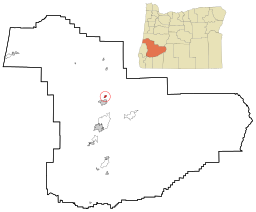Rural counties across Oregon face community health challenges exacerbated by stressed economies, aging populations, and behavioral factors.
Douglas County is a prime example -- ranking high in many risk factors that influence health including poverty, unemployment, tobacco use, obesity, and education.
Located in southwestern Oregon with a population of approximately 107,000, Douglas County recently released its Community Health Assessment (CHA), which provides a macro view of community health issues. The CHA revealed the county’s overall health needs attention. In fact, in the County Health Rankings, a collaborative project supported by the Robert Wood Johnson Foundation, Douglas County ranked in the lowest percentile of counties in Oregon in the 2013 ranking 30 out of 33 counties in the overall health outcomes category (Gilliam, Sherman, and Wheeler Counties were not included in the rankings). The county was also ranked 28 out of 33 in the health factors category with 21 percent of adults reporting fair or poor health, as compared to 14 percent statewide.
Its coordinated care organization, known as Umpqua Health Alliance, is taking these concerns seriously, with its community advisory council poised to make a difference according to Paul Morgan, its chair. Early next year, the council will prioritize those risk factors to the community’s well being and engage the community in strategies to improve its health.
Morgan is well aware of the difficulties ahead. One-third of adults in Douglas County are overweight, another 31 percent are obese. Research has shown that being overweight and obesity are associated with increased risk of type 2 diabetes, cancer, coronary heart disease, high blood pressure, stroke, liver and gallbladder disease.
And, the majority of Douglas County residents live in unincorporated areas creating geographic barriers, in some communities, to access to exercise facilities, grocery stores, and fresh foods. According to County Health Rankings, more of its residents are physically inactive (22 percent) than the rest of adults in Oregon (18 percent).
“All of us have our own issues (around not being physically active),” said Dr. Robert Dannenhoffer, who leads the CCO. “Our goal will be to work through people’s barriers to help them get moving. Poverty clearly makes a difference. But some of it is food isolation and some is not understanding the difference between healthy food and unhealthy food. Also, we have a county of hard working, really busy people and fast food is fast.”
In addition, 11 percent of the population in county are low-income and don’t live close to a grocery store, compared to 5 percent statewide. And 44 percent, nearly two times the national benchmark, of restaurants in the county are fast food restaurants.
Economic insecurity can have adverse consequences on the health of a community. Low-income people are more likely to smoke, to have high blood pressure, and to be obese, among other poor health indicators.
One in four children in Douglas County lives in poverty; 80 percent of children in Douglas County are eligible for free and reduced lunch. Sixteen percent of the total population in Douglas County are living in poverty (2007-2011), compared to 14.8 percent statewide. Due to significant poverty levels, the county has a higher percentage of residents that qualify for Medical Assistance Programs such as the Oregon Health Plan. The county has also had higher unemployment than the national and state averages.
Unemployment Rate
2004
2005
2006
2007
2008
2009
2010
2011
2012
Douglas County
9.3
8.3
7.5
7.7
9.9
15.4
14.7
13.3
12.2
Oregon
7.3
6.2
5.3
5.2
6.5
11.1
10.7
9.6
8.7
United States
5.5
5.1
4.6
4.6
5.8
9.3
9.6
8.9
8.1
Sources: Bureau of Labor Statistics, Local Area Unemployment Statistics (LAUS) data.
Bureau of the Census, Small Area Income & Poverty Estimates Program
“(There are) not a lot of group activities here (in Douglas County) with global low income and loss of hope so we smoke, use drugs and eat crap,” one focus group participant said.
In addition to economic instability and an aging population, 28.8 percent of Douglas County residents are age 60 and older, modifiable behavioral factors also influence the health of the community.
The cancer death rate is significantly higher in Douglas County (347 per 100,000) than the state (201.4 per 100,000). Cancer is often a result of advanced age, smoking, and obesity, all of which are prevalent in Douglas County. Furthermore, the incidence of chronic conditions such as high blood pressure, diabetes, asthma, and arthritis are higher than state percentages in every case.
Prevalence of Chronic Conditions, Age adjusted 2006-2009
Chronic Condition
Douglas County
Oregon
High Blood Cholesterol
35.1%
33%
High Blood Pressure
31.4%
25.8%
Diabetes
10.1%
6.8%
Asthma
12.7%
9.7%
Arthritis
36.8%
25.8%
Source: Oregon BRFSS County Combined Dataset 2006-2009
The number one leading cause of preventable cause of death in Douglas County is tobacco use; 27.1 percent of adults in Douglas County smoke compared to 17.1 percent statewide. While tobacco use statewide has been on the decline, more people smoke in Douglas County than did in the 1990s. Furthermore, nearly 1 in 4 women smoke during pregnancy in Douglas County which is much higher than the state average (11 percent).
“We really need to work on smoking,” said Dannenhoffer. “It (smoking) is the root of many of our issues.”
Studies have found a high correlation between smoking and drinking; people who smoke are much more likely to drink, and people who drink are much more likely to smoke. Like smoking, excessive alcohol consumption can contribute to chronic health issues. Fifteen percent of adults in Douglas County drink excessively, particularly men: 8.4 percent of males in Douglas County are heavy drinkers compared to 5.4 percent for men in Oregon overall.
FOR MORE INFORMATION
http://www.co.douglas.or.us/health/admin/documents/2013%C2%AD_0909CHA_Final.pdf
http://www.umpquahealthalliance.org/
http://www.countyhealthrankings.org/app/oregon/2013/rankings/outcomes/overall/by-rank
http://www.countyhealthrankings.org/app/oregon/2013/douglas/county/outcomes/overall/snapshot/by-rank
http://www.tobaccofreekids.org/research/factsheets/pdf/0260.pdf
http://millionhearts.hhs.gov/abouthds/risk-factors.html#hdIncome
http://frac.org/initiatives/hunger-and-obesity/are-hunger-and-obesity-related/
http://quickfacts.census.gov/qfd/states/41/41019.html
http://pubs.niaaa.nih.gov/publications/AA71/AA71.htm
http://www.umpquahealthalliance.org/community-advisory-council
Joanne can be reached at [email protected].
